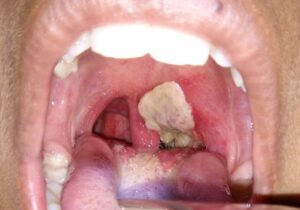Diphtheria is an acute illness caused by a toxin released from the bacterium C. diphtheriae. The DTaP vaccine prevents this illness. Dr. Bornstein will discuss practical insights into understanding the symptoms, causes, and treatments.

DEFINITION OF DIPHTHERIA:
An acute illness caused by a toxin released from the bacterium Corynebacterium diphtheriae.
SYMPTOMS:
- Runny nose and congestion
- Fever
- Sore throat
- Difficulty breathing, leading to:
- Stupor
- Coma
- Death
CAUSE OF DIPHTHERIA:
A toxin is released from the bacterium Corynebacterium diphtheriae.
CONTAGION:
Diphtheria is a contagious illness spread by coughing, sneezing, or talking. The illness incubates over two to four days.
DIAGNOSIS:
A physician will identify a white membrane in the nose or mouth. When the membrane is scraped, bleeding occurs. This, combined with the symptoms, makes diphtheria a possibility. A bacteria culture from a scraping of the membrane will confirm the diagnosis.
TREATMENT FOR DIPHTHERIA:
The treatment depends on removing the toxin from the body. One way is to prescribe an anti-toxin. Physicians may also prescribe antibiotics—such as penicillin or erythromycin—to kill the bacteria producing the toxin. If the disease progresses, supportive measures can be taken, such as fluids, bed rest, and good nutrition.
OUTCOME:
Before anti-toxins and antibiotics were available, diphtheria had a 50% death rate. This was due to suffocation from the membrane covering the airway. With antibiotics and anti-toxins, the mortality rate is less than 5% and is due to complications such as myocarditis (heart disease). With vaccination, this illness is very rare.
DISCUSSION:
Although there is still a long way to go, vaccination been slowly eradicating diphtheria. The illness is highly contagious, and susceptible individuals are at high risk. It usually starts as a simple cold, but it can rapidly progress to the mouth and throat, causing an obstructed airway. A white or gray membrane can be seen in the nose or mouth. If the illness is suspected, immediate treatment is necessary to prevent progression.
Complications of this illness include airway obstruction, myocarditis (heart disease), and neurologic problems such as paralysis of the eyes, diaphragm, and limbs. Once diagnosed, both treatment and isolation are necessary. Any exposed individuals should receive diphtheria toxoid and a shot of penicillin.
The vaccine is the only way to prevent contracting the illness. This vaccine is a part of the DTaP vaccine, which is administered at two, four, and six months of age. It is followed by a booster dose at fifteen months and four years of age. Td (Tetanus diphtheria) booster shots are given every ten years, starting at eleven years of age. With vaccination, the incidence of this illness has decreased from 70,000 cases per year to 2 cases per year—in children whose parents refuse vaccination.
ONE DOCTOR’S OPINION ABOUT DIPHTHERIA:
This disease is very rare now in the United States, thanks to vaccination. The vaccine has no serious side effects and should be given to everyone. There are still outbreaks of this illness in Eastern Europe and Russia, so we should not become complacent and miss the vaccine. This illness is easy to prevent, yet harsh if contracted. Vaccination cannot be stressed too much. My advice is to vaccinate.
This blog was written by Dr. Michael Bornstein, who has 30 years of experience as a pediatrician.
Disclaimer: The contents of this article, including text and images, are for informational purposes only and do not constitute a medical service. Please note that all images belong to their original owners. Always seek the advice of a physician or other qualified health professional for medical advice, diagnosis, and treatment.


FOLLOW US